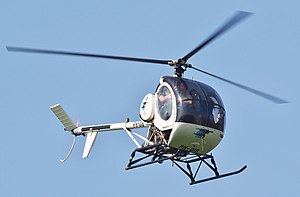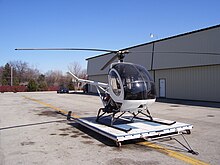
The Sikorsky S-76 is a medium-size commercial utility helicopter designed and produced by the American helicopter manufacturer Sikorsky Aircraft. It is the company's first helicopter specifically developed for the civilian market.
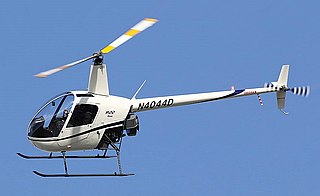
The Robinson R22 is a two-seat, two-bladed, single-engined, light utility helicopter manufactured by Robinson Helicopter Company. It was designed in 1973 by Frank D. Robinson, and has been in production since 1979.
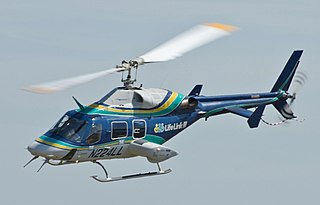
The Bell 222 is an American twin-engine light helicopter built by Bell Helicopter. The Bell 230 is an improved development with different engines and other minor changes.

The Aérospatiale Alouette II is a French light helicopter originally manufactured by Sud Aviation and later Aérospatiale. It was the first production helicopter powered by a gas turbine engine instead of the heavier conventional piston powerplant.

The Schweizer Aircraft Corporation was an American manufacturer of sailplanes, agricultural aircraft and helicopters located in Horseheads, New York. It was incorporated in 1939 by three Schweizer brothers, who built their first glider, the SGP 1-1, in 1930. Previously the oldest privately owned aircraft company in the United States, Schweizer was acquired by Sikorsky Aircraft Corporation of Stratford, Connecticut in 2004, and became a diversified aerospace company. Schweizer Aircraft ceased operations in 2012. It was sold to Schweizer RSG in 2018 and production lines were opened in Fort Worth, Texas. The company was producing two helicopter models in 2021. The 300C and 300CBI

Hughes Helicopters was a major manufacturer of military and civilian helicopters from the 1950s to the 1980s.

The Sikorsky R-4 is a two-seat helicopter that was designed by Igor Sikorsky with a single, three-bladed main rotor and powered by a radial engine. The R-4 was the world's first large-scale mass-produced helicopter and the first helicopter used by the United States Army Air Forces, the United States Navy, the United States Coast Guard and the United Kingdom's Royal Air Force and Royal Navy. In U.S. Navy and U.S. Coast Guard service, the helicopter was known as the Sikorsky HNS-1. In British service it was known as the Hoverfly.

The Hiller OH-23 Raven is a two, three, or four-place, military light observation helicopter based on the Hiller Model 360. The Model 360 was designated by the company as the UH-12, which was first flown in 1948. Initially it was a two-place helicopter powered by a piston engine that entered service in the late 1940s, it went on to be a popular military and civilian light helicopter in the late 20th century.

The Hughes TH-55 Osage is a piston-powered light training helicopter produced for the United States Army. It was also produced as the Model 269 family of light utility helicopters, some of which were marketed as the Model 300. The Model 300C was produced and further developed by Schweizer after 1983.

The Bell 214 is a medium-lift helicopter derived from Bell Helicopter's ubiquitous UH-1 Huey series. The Bell 214ST shares the same model number, but is a larger, much-modified twin-engine derivative.

MD Helicopters, LLC. is an American aerospace manufacturer. It produces light utility helicopters for commercial and military use. The company was a subsidiary of Hughes Aircraft until 1984, when McDonnell Douglas acquired it and renamed it McDonnell Douglas Helicopter Systems. It later became MD Helicopters in 1999 after McDonnell Douglas merged with Boeing.

The Sikorsky X2 is an experimental high-speed compound helicopter with coaxial rotors, developed by Sikorsky Aircraft, that made its first flight in 2008 and was officially retired in 2011.

The Schweizer 330 and S333 are turbine-powered developments of the Schweizer 300 light piston-powered helicopter. As of 2007, only the Schweizer 333 remains in production. In February 2009, the 333 was rebranded as the Sikorsky S-333. In 2018 the Schweizer R.S.G. bought the Schweizer Aircraft from Sikorsky Aircraft and it was rebranded as Schweizer S333 again.

The Enstrom F-28 and 280 are a family of small, light piston engine powered helicopters produced by the Enstrom Helicopter Corporation.

The Sikorsky S-52 is a utility helicopter developed by Sikorsky Aircraft in the late 1940s. It was used by the U.S. Navy, Marine Corps, and Coast Guard. The S-52 was the first US helicopter with all-metal rotor blades. Initially a two-seater, it was developed into the four-seat S-52-2 and S-52-3. It was designated HO5S-1 by the U.S. Navy and Marine Corps, HO5S-1G by the Coast Guard, and YH-18A by the U.S. Army, and was used extensively by civil operators after being retired by the military.

The Bell 47J Ranger is an American single-engine single-rotor light helicopter manufactured by Bell Helicopter. It was an executive variant of the highly successful Bell 47 and was the first helicopter to carry a United States president.

The Canadian Home Rotors Safari is a kit helicopter, produced by CHR International of Marianna, Florida, and formerly produced by Safari Helicopter of Ear Falls, Ontario.

The Sikorsky Firefly is an all-electric helicopter built for research purposes by Sikorsky Aircraft. It has been called the world's "first all-electric helicopter". The Firefly is a modified Sikorsky S-300C helicopter with its engine replaced by an electric motor and two lithium-ion battery packs. The helicopter would hold only the pilot and no passengers. Sikorsky reported an operating time of 12 to 15 minutes and a top speed of 80 kn.

The Enstrom TH180 is a single piston-engined two-place training helicopter manufactured by Enstrom in the United States.
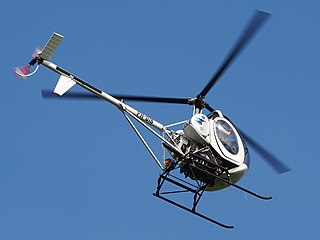
On 8 September 2017, a Schweizer 269C helicopter crashed after an uncontrolled descent during a power-off landing attempt at the Flying W Airport in Medford, New Jersey, United States. The aircraft had experienced engine trouble during a local sightseeing flight for the benefit of passenger Troy Gentry, cofounder and member of American country music duo Montgomery Gentry, which was scheduled to perform at a resort at the airport later that day. The pilot died at the scene; Gentry was pronounced dead after being taken to a hospital.
